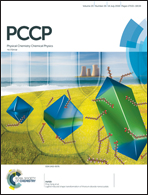How interface compatibility affects conductivity evolution of silver nanobelts-filled electrically conductive composites during cure and post-treatments†
Abstract
Using silver nanobelts and silver microflakes in a DGEBA/TETA epoxy matrix, we sought to investigate the relationship between the evolving electrical resistivity of formulations of hybrid nanocomposites during the curing process. This was characterized using three methods: (i) in situ four-wire electrical resistance measurements; (ii) differential scanning calorimetry, and (iii) dilatometry. In a previous work we reported that the resistivity of microcomposites was strongly affected by partial vitrification during curing. In this study, the reported vitrification effect is observed again, further validating the concern of far-ranging implications on the industry practices. The addition of silver nanobelts greatly improved conductivity of the composites, though it was observed that the improvements are often lost during subsequent heating and cooling cycles. Resistivity observations indicate that the sensitivity may be due to insufficient nanobelt–nanobelt contacts in the composite, and thus further increasing the nanobelt fraction of the filler content can maximize conductivity.



 Please wait while we load your content...
Please wait while we load your content...